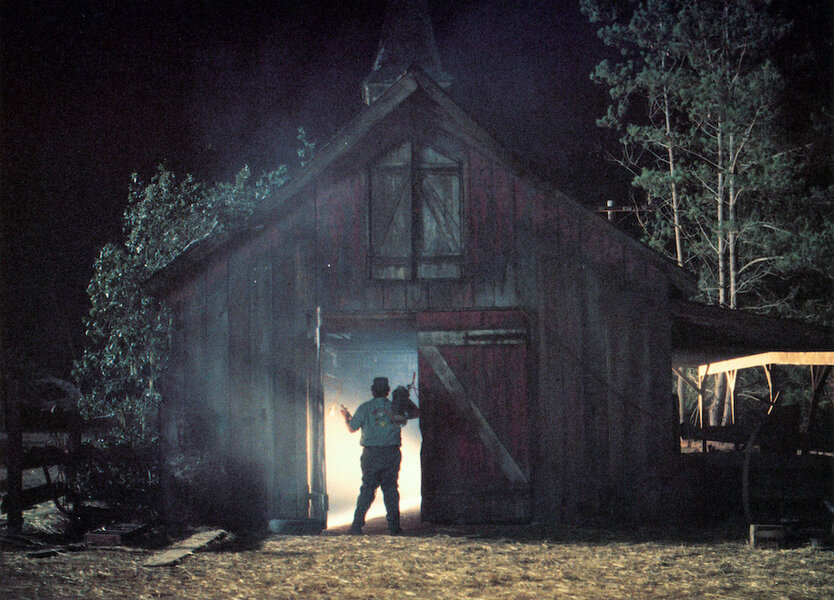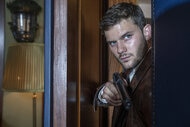Create a free profile to get unlimited access to exclusive videos, sweepstakes, and more!
Arachnophobia: Frank Marshall On Why He Wanted to do for Spiders What Hitchcock Did for Birds
Getting arachnids to do what you wanted in the age before CGI was a major pain in the thorax.

Spiders... why did it have to be spiders? The answer is simple: Frank Marshall liked the script.
By the late 1980s, Steven Spielberg's longtime producing partner was ready to sit in the director's chair. That desire to steer the feature-length ship materialized in the form of 1990's Arachnophobia, a B-movie send-up about a San Francisco physician (played by Jeff Daniels) who relocates his family to a small California town that's suddenly overrun by a horde of deadly spiders.
Arachnophobia director Frank Marshall recalls origin of 1990 horror-comedy
"I had been doing a lot of second unit directing up to that point," Marshall told SYFY WIRE over Zoom back in 2022. "Jeffrey Katzenberg brought the script to me and said, ‘We think it's time for you to move up into the first chair.’ I looked at the script, and I felt it had the elements that interested me and that it was something that I could handle."
Reminded of the classic films he grew up on, the first-time director wanted to put a Hitchcockian spin on the eight-legged creatures that scare the ever-loving bejesus out of 3-15 percent of the human population.
"I felt that it had a nice blend of horror and humor and that we could emphasize that," he continued. "I liked what Hitchcock did with The Birds, where the movie wasn't really about birds; it was really this story about romance and these two characters in this town, and then the birds take over. I wanted to do that in Arachnophobia, where Jeff Daniels and his family move. There's a whole other story going on and then the spiders become the main character, just like in The Birds."
Marshall lets out a chuckle when we ask if he's afraid of spiders in real life. "I don't have arachnophobia," he said, explaining that his overall goal was to make the audience squirm by placing the creepy crawlies into everyday situations we often take for granted.
"Your slipper, your popcorn, in the bathroom," Marshall added. "Places that you don't ordinarily think that they might be, but you [encounter] every day. I think that made it much scarier than trying to create a situation that was unique or unusual. I think the commonplace situations with spiders makes everybody scared of them."
Steven Spielberg's contribution to Arachnophobia
Basing the terror in a modicum of realism helped reinforce its efficacy in the mind of the audience. For instance, the film opens in the jungles of Venezuela, where a research expedition led by arachnid expert, Dr. James Atherton (Julian Sands), discovers a new species of lethal spider, which ends up making its way to the United States for a little killing spree, only found within a very concentrated area.
"We had discovered that the tepuis in Venezuela have these sinkholes in them, where there could be species that have existed that we haven't seen before and could almost be aliens or, in this case, a poisonous spider that nobody knew," Marshall said. "We had seen this story in a National Geographic magazine and we went to scout the tepuis and I said, ‘Well we got to shoot here.’"
They did just that, shooting on location in South America — "we actually went to the tepuis and camped out and shot on top of them, helicoptered in" — as well as constructing an extensive jungle set at MGM for the sequence in which Dr. Atheron and his team collect specimens by knocking them out with heavy clouds of smoke. "That's all true, that's all real. I think that adds to the audiences then understanding that this could really happen, so it makes it scarier."
Executive producer Steven Spielberg visited this particular set and even helped set up a shot.
"It’s a really great shot," Marshall told us. "It's the shot where Julian Sands captures one of the spiders that drops from the canopy in the jungle and he brings it over in a glass jar and it sort of jumps out. That's a real tarantula. Steven designed the shot for me. He said, ‘Have him bring it into a close-up.' So we did that and it works great."
Can spiders be funny?
Adding a comedic edge to the proceedings ensured that things never became too serious. The very idea of killer spiders is inherently campy, so Marshall and his team wisely leaned into the silliness of their premise, which meshed perfectly with the fanged horror.
"When people get scared, they like to then have a bit of relief and the comic relief is there in the characters, in the situations, to kind of make fun of things," he said. "So you get scared, but then you get to relax because you're laughing. A lot of that came down to working with the writer, Wesley Strick, and designing those scenes so we had a bit of a break in between. And, of course, casting John Goodman brought a lot to the party as well."
He is, of course, referring to the character of Delbert McClintock, the eccentric exterminator who steals every scene he's in, despite the fact that he has limited screen time. "As actors do, they bring personal experiences to it," Marshall added, referring to the fact that Goodman based his performance on a memorable biology teacher from high school. "That’s what made the character funny. The first time he came up, he just did the character and I loved it and I said, ‘Do more of that.’"
Given that this was several years before Jurassic Park brought CGI into the mainstream, Arachnophobia made use of practical animatronics and living spiders such as tarantulas and Delenas (a harmless species native to New Zealand).
"I looked at where visual effects were back then and determined that they weren't at a level that I could really have CGI spiders," Marshall recalled. "There's only one [CG] shot in the movie, and it's a big wide shot that has spiders on the house. The solution to that was to have real spiders, as well as one or two animatronics for the big spider, ‘Big Bob.’ But the rest of the spiders, the little spiders, they were all real."
The actual arachnids were managed on set by famed "insect wrangler" and entomologist, Steven R. Kutcher. Since one can't really train a spider like other animals, unique methods were used to move them around for certain shots.
"They knew how to motivate the spiders, usually with a hairdryer," Marshall revealed. "And we would spray Pledge, the furniture polish, in places we didn't want them to go because their little feet would slip on the pledge. So it was kind of a barrier that you couldn't see. But hot air moved them and basically, when I would shoot a scene, I would kind of let the spider decide what the action was going to be."
He continued: "We kind of did a spider Olympics, where we found some spiders were faster than others, some could climb better than others. So they would go in this spider condominium that we had with all these drawers on the set. There'd be fast spiders, there'd be climbing spiders — all of the same variety. Some were better at doing things than others, so we separated them just like you would do with stuntmen."
The legacy of Arachnophobia
Arachnophobia crawled up the waterspout and into theaters on July 20, 1990. Bolstered by positive reviews ("an exciting and thoroughly enjoyable, experience," Empire Magazine declared at the time), it brought in just over $53 million domestically against a production budget of $31 million.
Despite this critical and financial success, Marshall confessed he never seriously considered a sequel. "I wanted to go on and make other movies and tackle other subjects. I hadn't really thought about it." Over the last 32 years, the filmmaking veteran has helmed four other projects, including 2020's acclaimed Bee Gees documentary, How Can You Mend a Break Heart.
And while a follow-up to Arachnophobia never materialized (more on that below), it did help pave the way for other arachno-comedies like Ellory Elkayem's underrated Eight-Legged Freaks (2002) and Mike Mendez's Big Ass Spider! (2013).
In the summer of 2018, it was reported that Amblin had partnered with producer James Wan and his Atomic Monster banner for a remake of the 1990 film. Christopher Landon (Happy Death Day, Freaky) is currently slated to direct, with Marshall on board as an executive producer, though at the time of our call Marshall wasn't sure whether it would be a sequel or reboot. He quickly went on to clarify, "I will know soon."
Arachnophobia is now streaming on Peacock.
Originally published Oct 28, 2022.




























